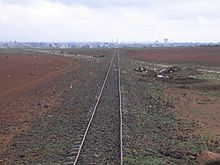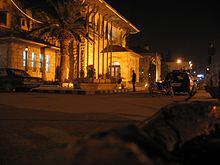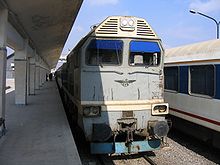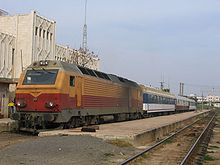Rail transport in Syria

The rail transport in Syria consisted of three subsystems: Two narrow gauge networks by the Hejaz railway company operated, and the standard gauge network , a state-owned company that internationally under the French-speaking designation CFS - Chemins de fer Syria's trades. As a result of the civil war in Syria , the rail infrastructure was so badly damaged that there has been no rail traffic since July 2012.
History and network
Starting position
Until the last decade of the 19th century there was no railroad in the Arab provinces of the Ottoman Empire . The traffic connections were inadequate, the roads in poor condition and often not to use in the rainy season. Only pack animals could get on here. The transport costs were therefore high. Railway construction gave the country an important economic boost.
French railways
The first railways on what is now Syrian territory were created by the Société des Chemins de fer Ottomans économiques de Beyrouth-Damas-Hauran . It was the Hauran Railway from Damascus to Muzairib , opened in 1894, and the Lebanon Railway from Damascus to Beirut (1895). This happened in the rare gauge of 1050 mm from the Algerian area and the French colonial tradition . The operating company was led at the end of the 19th century after the merger with a Belgian company under the name Société Ottomane du Chemin de fer Damas-Hamah et Prolongements (DHP) .
Hejaz Railway
Another railway system on what is now Syrian territory was built in 1900 with the Hejaz Railway. The DHP's track width of 1050 mm was chosen because, on the one hand, the Ottoman state negotiated with the operator regarding a takeover of the Hauran Railway - which failed. On the other hand, rolling stock for the construction of the Hejaz Railway could be transported to Damascus in this way without any problems - a logistical advantage that should not be underestimated due to the lack of roads. However, due to the competitive situation before the First World War, there was never a track connection between the railways.
The routes of the Hejaz Railway established at that time on what is now Syrian territory were:
- The main route between Damascus and Medina . It was put into operation along its entire length in 1908, the sections located in Syria went into operation in 1902 and 1903.
- The line from Darʿā to the port of Haifa , the most important route for the operating results of the railway, was navigable in 1904, regular operations began in 1906.
- The route from Darʿa to Bosra (39 km) was built in 1911/1912. This should open up the granary of the Hauran Mountains and strengthen the military control of a main settlement area of the Druze . As early as 1914, however, it was dismantled again in order to use rails and sleepers for the extension of the Hejaz Railway in Palestine to the south in the direction of the Sinai front. In 1924 the line was relocated again under the direction of the DHP.
Baghdad Railway and other standard gauge
The Société Ottomane du Chemin de fer Damas – Hamah et Prolongements (DHP) also built the line between Rayak ( Lebanon ), Homs and Aleppo , but with regard to the technical parameters of the Baghdad Railway under construction it was the first standard-gauge railway on what is now Syrian territory . In order to save a few kilometers of track, it was not led directly to Damascus, but to Rayak on the Lebanon Railway. Because of the different track widths, all goods had to be reloaded and all passengers had to change. This transferred the capacity bottlenecks on the narrow-gauge railway to the entire connection. The Rayak – Aleppo line was inaugurated in 1906.
1911 was added - also by the Société Ottomane du Chemin de fer Damas - Hamah et Prolongements (DHP) - the Homs - Tripoli line in standard gauge.
The - as yet unfinished - Baghdad Railway did not reach Aleppo until 1912. Its section between today's Syrian / Turkish border with the border stations Midan Iqbas (Syria) and İslahiye ( Turkey ) on the one hand and Radschu on the other hand was not even completed until 1915. The most beautiful and largest station building on this route was built in Aleppo. The station was completely renovated in 1993 and is still called Baghdad Station to this day , a name from the time when there was still an asch-Scham station ("Damascus station") in Aleppo , where the trains of the Société Ottomane du Chemin de fer Damas– Hamah et Prolongements (DHP) ended, but it no longer exists today.
Another section of the Baghdad Railway, further east, also came to lie on Syrian territory, the section between Qamishli , the Syrian border station opposite the Turkish Nusaybin , and al-Yarubiyya on the border with Iraq . This line was completed in two sections in 1933 and 1935.
600 mm track
During the period of the French mandate, there was a 35 km long 600 mm narrow-gauge railway between Esra on the Hejaz Railway and as-Suwaida for about 10 years from 1925 .
French protectorate
Rail traffic in Syria became increasingly less important after the First World War. The expansion of the road network came to the fore. The railways consisted of three disjointed or technically incompatible systems (eastern and western Baghdad railway, separated by Turkish territory and the narrow-gauge network in southern Syria). The rail network was in poor condition, the average speed was no more than 40 km / h.
Railroad in Syria
The 2460 km standard gauge network that exists today is therefore relatively new. For the most part, it was not created until after 1970.
Starting position
When Syria became independent in 1941, it had an unattractive rail network 557 km in length. It was characterized by the fragmentation into sub-networks. Damascus could only be reached from the north via Lebanon and with a change of lane, Iraq only when crossing Turkish territory. The two Syrian Mediterranean ports had no rail links at all. The founding of the Syrian State Railways (CFS) in 1956 did not change this situation either.
Expansion program
Since the mid-1960s, the Syrian government has been striving for a modern, high-performance railway network in order to meet the high demands on transport capacity that had developed in previous years. This new demand was caused by the great economic growth in Syria, especially in the second half of the 1970s, after the discovery and the start of mining of large phosphate deposits, and by rapid agricultural development on the Euphrates .
In the mid-1970s, as a result of the Lebanese civil war, traffic on the Damascus – Beirut route and thus Syria's only rail link to a Mediterranean port , as well as the Homs – Rayak – Damascus connection, which also ran through Lebanese territory, was finally interrupted. In particular, the two Syrian ports, Latakia and Tartus, were to be connected to the rail network and the capital Damascus to be connected to the standard gauge network.
Modern route network
This has resulted in the following expansion program since the late sixties:
- Connection of the port of Tartus by a 42 km long route to Akkari on the Homs – Tripoli line, which has existed since 1911 (1967/1968). However, the final start of operations did not take place until 1981, after the construction of a new line section which - in contrast to the existing line - circumnavigated Lebanese territory. A large part of the Syrian phosphate production is carried out over this route .

- A 750 km long stretch from the port of Latakia via Aleppo to the oil fields near Qamishli in northeast Syria was put into operation in stages between 1974 and 1976. The end point of this route is at the Baghdad Railway, which runs from Turkey to Iraq . The Soviet Union provided great financial and technical support for the construction of this railway line . The line connects Aleppo to its most important port to the west and the Euphrates region to the east. Given the right political conditions, it could play an important role in transit traffic between the Mediterranean and Iraq.
- Phosphate is also transported away on a route opened in 1980, which runs from Mahin train station in an easterly direction to Palmyra ( Tadmur ), but ends about 50 km from the city in ash-Sharqiyya. The incorrect other information is often found in the literature and on maps.
- In 1983 the capital Damascus was also connected to the standard gauge network.
- The 80 km long gap in the Mediterranean rail network between Latakia and Tartus was closed in 1992.
The Hejaz Railway network was expanded in 1976 to include a 34-kilometer stretch from Damascus to Qatana , which was primarily intended to serve the local military base. The route is no longer used today.
Projects
The following projects were discussed before the civil war:
- From Deir ez-Zor , a 150-kilometer route to Abu Kamal and on to Baghdad was to be built since 1981 . For political reasons, Syria stopped work in 1982. In February 2007 there was no sign of any construction work.
- A 203-kilometer line from Deir ez-Zor to Tadmur (Palmyra) only exists on the drawing board.
- Parallel to the Hejaz Railway, a 160 km / h route to Darʿa and on to Jordan was to be built since 1996. This also only exists on the drawing board.
- Another dream of the future is a new underground train station in Damascus with a central location. In anticipation of this, the Damascus-Qanawat terminus was closed, the track field removed and replaced by a construction pit that had apparently been inactive for a long time in February 2007.
- A modernization program was in progress in which the signal boxes along the Tartus - Latakia and Aleppo - Qamishli routes will be equipped with modern electronic signal box technology.
Civil war
Due to the civil war in Syria , rail traffic has been idle since July 2012. The rail infrastructure has been largely destroyed. The Islamic State even declared railways to be "immoral" and recommended donkeys and horses as the correct transport solution.
Freight traffic between Latakia and Homs was resumed on October 21, 2016 . The Schinsare power plant is supplied with fuel in this way. On January 25, 2017, for the first time in four years, a passenger train ran between Jibrin Station (near Aleppo Airport ) and Baghdad Station in Aleppo. It was a propaganda campaign. Four pairs of trains are planned daily on this route.
After repairing the 309-kilometer stretch between the port city of Tartus and Al-Sabinah in the south of Damascus, the first freight train with grain was able to run after eight years on August 8, 2020. In addition, there is again passenger traffic with two weekly trains on the coastal route between Tartus and Latakia. Otherwise, rail traffic is still at a standstill.
business
The following information relates to the time before the beginning of the civil war.
Syria's railway lines are single-track and not electrified. A maximum speed of 120 km / h is permitted on an approximately 20-kilometer stretch of the Damascus – Aleppo highway. Otherwise the maximum speed there is 110 km / h. On the other routes it is 80 km / h.
Only a few routes are secured with light signals . Most of the network is driven with written driving commands .
Standard gauge
The regular track network is operated by the CFS. The main administration is based in Aleppo . As a result of the strong competitive pressure from the road, the number of trains offered by CFS is limited. Several trains run daily on the Aleppo – Latakia route, both express trains with few stops on the way and trains that stop at every station.
The new Korean railcar operates both on this route and between Damascus and Aleppo. The demand between Aleppo and Latakia is quite high. Several trains run on the main Aleppo – Damascus route with departure times between midnight and 5 am; In the opposite direction from Damascus to Aleppo there are several trains with departure times between 3:25 p.m. and shortly after midnight. The train from Damascus at 3:25 p.m. and 5 a.m. from Aleppo is currently being operated with the new Korean diesel multiple units. The number of passengers is trending upwards.
Freight traffic predominates by far.
International connections
The connection to Istanbul had been suspended for a long time. In the past, through coaches ran from Aleppo to Istanbul, which were attached to the Taurus Express (Gaziantep – Adana – Istanbul) in the Turkish border station Fevzipaşa . There was also a weekly international connection from Damascus to Iran. It was discontinued in or after December 2011 due to the civil war in Syria.
Since 2009 there were again three connections with Turkey via the border crossings İslahiye / Meydan Ekbez , Qamishli / Nusaybin and Karkamis / Cobanbeyli . in operation. They too were discontinued due to the civil war in Syria. The Aleppo-Gaziantep connection in December 2010, but then temporarily resumed in May 2011.
Narrow gauge
Scheduled traffic has been discontinued on the entire Hejaz Railway network since the end of 2006. The main route is passable in its section in Syria, as is the route from Dara to Bosra. The route from Darʿā to the Jarmuk Gorge , which formerly led to Haifa, is only partially accessible behind the Muzairib station. The routes can be used for special trips, for example on the occasion of the Bosra Festival or for railroad fans.
The Lebanon Railway was destroyed on the Lebanese side during the Lebanese civil war between 1976 and 1990. On the Lebanese side, traffic was abandoned in 1976. On the Syrian side, operations initially continued as far as the Sarghaya border station until 1980, then it was abandoned, but has been resumed in part since 1982. However, the volume of traffic was low and the facilities deteriorated over the years. Finally, in the urban area of Damascus, the rail connection to the tracks of the Hejaz Railway was interrupted, so that an island operation was created. The traffic was reduced further and now consists only of tourist weekend traffic between the train stations of al-Hama, where the vehicles are parked, and Ain Fija.
vehicles
| origin | Series and locomotive type | number | power | Year of delivery |
|---|---|---|---|---|
| France | LDE 650 | 9 | 650 hp | since 1968 |
| Soviet Union | LDE 1200 (type TEM 2) | 11 | 1200 hp | 1973-1975 |
| Ireland | Anielok | 6th | 1976 | |
| General Electric (USA) | LDE 1800 (type U 17 C) | 26th | 1800 hp | 1976 |
| Soviet Union | LDE 2800 (type TE 114) | 77 | 2800 hp | 1982-1985 |
| Czechoslovakia | LDE 1500 (type ČME 3) | 25th | 1500 hp | 1983 |
| Alstom (France) | LDE 3200 (type Prima DE 32 C AC or AD 33 C) | 30th | 3200 hp | Late 1999 |
Locomotives and railcars
Apart from the four-axle French B&L locomotives of the LDE 650 series, the CFS diesel locomotive fleet consists only of six-axle diesel-electric machines. After the turn of the millennium, CFS began a modernization program for the LDE 2800 series, which will be equipped with General Electric motors. The Russian diesel locomotives have been modernized by General Electric since 2001 and are equipped with a twelve-cylinder 7FDL12 diesel engine. The Swedish company Uraenergie is also modernizing 32 diesel locomotives.
For traffic between Damascus and Aleppo and Aleppo and Latakia, five-part railcars for a top speed of 160 km / h from Korean production have been successively supplied since 2006 .
Passenger cars
Most of the approx. 450 passenger coaches come from the years 1970–1983, from the former GDR , a smaller part from Romania and Poland . Some have been overhauled by the Iranian company Wagon Pars since 2001 , and many can also be seen rotting in parking facilities.
There are first and second class cars as well as dining , sleeping (there should be 44) and baggage cars.
Freight transport

Freight traffic takes place almost exclusively with block trains . It is used to transport crude oil , natural gas , phosphate, grain, cement , containers , building materials and more. There are around 5000 freight cars. Most were built between 1960 and 1975. Since the 1990s, new grain wagons have been imported from Iran in large numbers, which were built at Wagon Pars . The following numbers are given:
- 1294 Heavy Transport Flat Car
- 846 gondolas
- 818 oil tank cars
- 762 boxcars
- 597 grain wagons
- 323 phosphate cars
- 178 sliding wall wagons
- 146 hopper cars
- 53 flat cars
- 50 pressurized gas tank cars
- 45 cement cars
- 20 water tank cars
- 19 dump trucks
Many freight wagons can also be seen rotting in parking facilities.
Construction vehicles
There are crane and other company cars for maintaining the track construction. Particularly noticeable are the three-axle conversion cars from the 1950s, some of which still have a DB logo.
gallery
proof
literature
- Johannes Müller, Syria and the Hejaz Railway = Steam and Travel / Overseas Railways 1/1989.
- Dieter Noll (Ed.): The Hejaz Railway. A German railway in the desert. Werl 1995, ISBN 3-921700-68-X .
- Erika Preissig and Günther Klebes, Railway construction and railway projects in the Orient and the economic and political goals pursued with them, in: Yearbook for Railway History 21 (1989), pp. 43-102.
- Matthias Hille, Syria - The State Railways CFS in 2009 , Eisenbahn-Kurier, issue 1/2010, pages 74–78
swell
- Visit as part of a study trip of the German Society for Railway History in February and March 2007.
- Private website www.syrische-eisenbahn.de
- Syrian Railways website, arab.
References
- ↑ See: Samuel Rachdi. In: Fahrplancenter News 54 (October 2015 to April 2016), p. 16.
- ↑ hjs: route Latakia - Homs . In: IBSE telegram 312 (November 2016), p. 6.
- ↑ red: Passenger train traffic in Halab / Aleppo . In: IBSE telegram 314 (1/2017), p. 9.
- ↑ Damascus freight service resumes after reinstatement of war-damaged railway. Railway Gazette International , August 11, 2020, accessed on August 11, 2020 .
- ↑ HaRakevet No. 99 = vol. 26/4, p. 17.
- ↑ fsp: Turkey: cancellation of international train connections . In: IBSE-Telegram 268 (March 2013), p. 6.
- ↑ ANSAmed: Transport: Aleppo-Mersin Passenger Train to Start on 13 March ( page no longer available , search in web archives ) Info: The link was automatically marked as defective. Please check the link according to the instructions and then remove this notice. , March 2, 2009
- ↑ Arab Turkisch Travel Gazette: Third railway gate between Turkey-Syria opens ( Memento of the original from July 7, 2011 in the Internet Archive ) Info: The archive link was inserted automatically and has not yet been checked. Please check the original and archive link according to the instructions and then remove this notice. , December 26, 2009
- ↑ fsp: Turkey: cancellation of international train connections . In: IBSE-Telegram 268 (March 2013), p. 6.
- ^ For example, as part of a DGEG study trip in February 2007
- ↑ Railway engineer 10/2006, p. 70




































